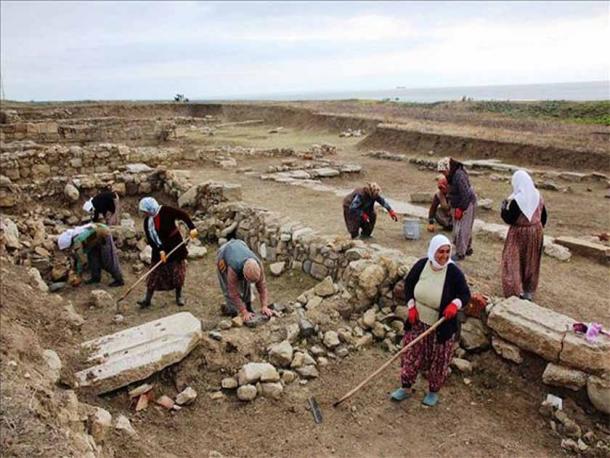
2,800-Year-Old Thracian “Pharmaceutical” Center Unearthed at Heraion Teikhos, Turkey
In 2021, a team of researchers unearthed a 2,800-year-old temple at the ancient Thracian city of Heraion Teikhos, in Turkey. Now, a water system has been identified leading to a space within the temple which researchers are calling an “ancient pharmaceutical production area.”
Digging the Thracian City of Heraion Teikhos
The ancient Thracian city, Heraion Teikhos, is located on the north coast of the Sea of Marmara, in the region of East Thrace, in the northwestern Turkish province of Tekirdağ.
Back in 2021, in the city's acropolis, archaeologists excavated an ancient Thracian civilization temple loaded with rare artworks, which is thought to have been lost in a fire that occurred in 2 BC.
Professor Dr. Neşe Atik told Hurriyet Daily News that a team from Istanbul Rumeli University have been excavating at Heraion Teikhos since 2000. While the temple itself is mostly ruinous, the researchers have removed statues of gods including “Kybele, Eros and Aphrodite as well as bronze coins, amphora and similar pieces from the temple,” said Atik.
Now, the archaeologists have announced their identification of a pharmacological production unit, with its own dedicated water supply system.
- The Voyage of Aeneas of Troy: Did it Really Happen?
- Mushroom Monuments of Thrace and Ancient Sacred Rites

Professor Dr. Neşe Atik with one of the statues found earlier at the site. (Suleymanpasa Municipality)
Who Were the Thracians?
The Thracians were a group of tribes renowned for their rich culture and formidable warriors, that thrived in Southeast Europe from as early as 2000-1500 BC. Inhabiting an area that spans modern-day Bulgaria, Greece, and Turkey, the Thracians were not a single nation but a conglomerate of tribes sharing similar customs, art, and language. Despite their lack of a centralized political structure, they left an indelible mark on the historical landscape of the region.
The Thracians are perhaps best known for their exquisite metalwork, especially in gold and silver, and for figures like the legendary Spartacus, who was of Thracian origin. Their culture, interwoven with Greek and later Roman influences, contributed significantly to the tapestry of classical antiquity, yet remains shrouded in mystery due to the scarcity of written records.
Pharmacology in the Ancient World
In the 8th century BC, most civilizations had a class of physicians, herbalists, and specialized healers. Medical practices were conducted at temples, in areas distinctly separated from the religious activities taking place at the sanctuaries. Dr. Atik said, the excavation team at Heraion Teikhos have two clear goals: to protect the settlement for cultural tourism, and to introduce the site to the scientific world.
Over the last 20 years this site has yielded statues, terracotta pots, metal finds and coins, but now the primary aim is to excavate the “pharmaceutical production area”.
Furthermore, they are trying to establish how water was transported to the medical center. Atik said, at that time, water systems in hilltop settlements “were usually built with large water cisterns”. However, in this case, water was not supplied from cisterns, but from a wooded area several kilometers east of the excavation site.
- High Tech Roman Water System Frozen In Time Near Pompeii
- 9 Ancient Physicians and Legendary Healers that Changed Medicine Forever

Investigators excavating part of Heraion Teikhos, ancient Thracian city. (Suleymanpasa Municipality)
Ancient Thracian Medical Archaeology
The excavators have identified a series of terracotta pipes connecting pools of water with stone channels. It was this discovery that led to the team to identifying evidence of pharmaceutical production, which Atik said “was spread across the entire excavation area.” She added that this discovery is scientifically important since it represents the first time archaeologists have found medicine ovens and a water system so close to each other.
Skulls of contemporary Thracian people, dated back to the 8th millennium BC, have been discovered in Durankulak, the most remote northwestern settlement in Bulgaria. Delicate circles carved into the bones were identified as “trepanation” marks, but no medical tools were found. However, in a Thracian tomb excavated in Karanovo, “a set of 18 silver and gold surgical instruments was found near the skeleton,” notes Associate Prof. Krassimir Koev part of the investigating team in 2011.
Matching the shape and functionality of modern medical devices, this discovery demonstrated the high level of medical knowledge with ancient Thracian culture.
What Might Soon Be Unearthed?
When the ancient Thracian doctor was unearthed at Karanovo, Associate Prof. Krassimir Koev proposed that “an organized form of medical treatment existed with the Thracians.”
Now, the discovery of the medical center at the Heraion Teikhos temple not only cements these earlier speculations, but it is hoped that the inner secrets of ancient Thracian “pharmacologists” might soon be revealed.
Contemporary ancient Greeks called medicine “ iatrikē”(Greek: ἰατρική), and they intertwined the spiritual with the physical, believing health was affected by the humors: geographic location, social class, diet, trauma, beliefs, and mindset. They believed that illnesses were divine punishments and that the arts of healing were gifts from the Gods.
Over time, the spiritual beliefs regarding "punishments" and "gifts" were eventually replaced, founding the study of medicines, void of godly powers. Only time will tell, but a similar evolution from divine to practical medicines might soon be established in the Thracian civilization.
Top image: Heraion Teikhos, ancient Thracian city in modern day Turkey. Source: Tekirdağ Provincial Directorate of Culture and Tourism
By Ashley Cowie















